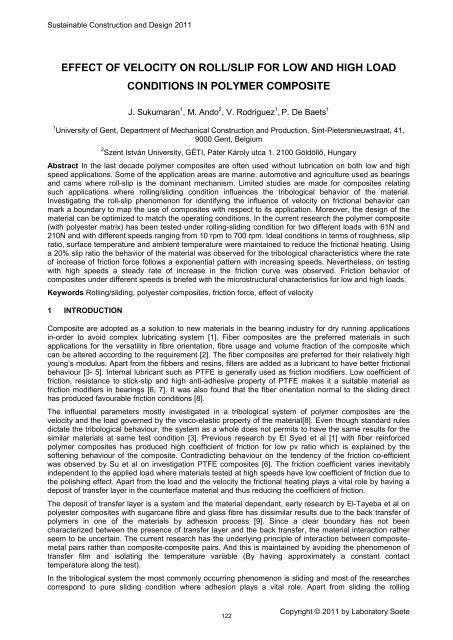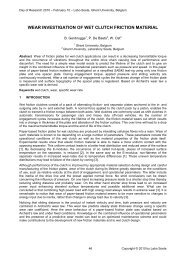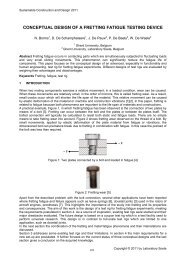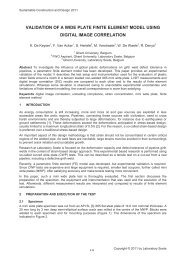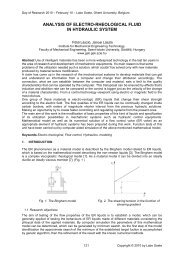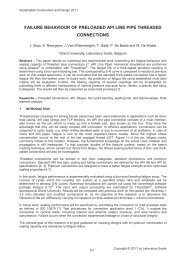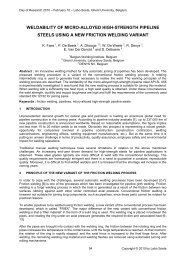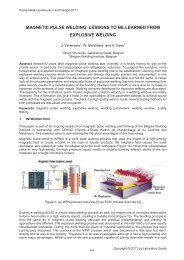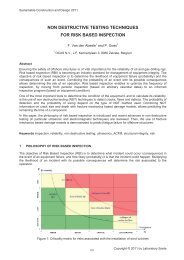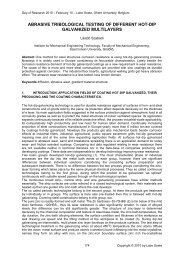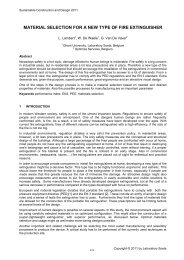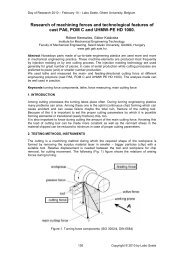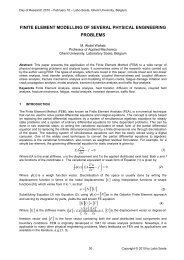Volume 2, Issue 1, 2011, Full Text - 5th International Conference on ...
Volume 2, Issue 1, 2011, Full Text - 5th International Conference on ...
Volume 2, Issue 1, 2011, Full Text - 5th International Conference on ...
Create successful ePaper yourself
Turn your PDF publications into a flip-book with our unique Google optimized e-Paper software.
Sustainable C<strong>on</strong>structi<strong>on</strong> and Design <str<strong>on</strong>g>2011</str<strong>on</strong>g><br />
EFFECT OF VELOCITY ON ROLL/SLIP FOR LOW AND HIGH LOAD<br />
CONDITIONS IN POLYMER COMPOSITE<br />
J. Sukumaran 1 , M. Ando 2 , V. Rodriguez 1 , P. De Baets 1<br />
1 University of Gent, Department of Mechanical C<strong>on</strong>structi<strong>on</strong> and Producti<strong>on</strong>, Sint-Pietersnieuwstraat, 41,<br />
9000 Gent, Belgium<br />
2<br />
Szent István University, GÉTI, Páter Károly utca 1. 2100 Göldöllő, Hungary<br />
Abstract In the last decade polymer composites are often used without lubricati<strong>on</strong> <strong>on</strong> both low and high<br />
speed applicati<strong>on</strong>s. Some of the applicati<strong>on</strong> areas are marine, automotive and agriculture used as bearings<br />
and cams where roll-slip is the dominant mechanism. Limited studies are made for composites relating<br />
such applicati<strong>on</strong>s where rolling/sliding c<strong>on</strong>diti<strong>on</strong> influences the tribological behavior of the material.<br />
Investigating the roll-slip phenomen<strong>on</strong> for identifying the influence of velocity <strong>on</strong> fricti<strong>on</strong>al behavior can<br />
mark a boundary to map the use of composites with respect to its applicati<strong>on</strong>. Moreover, the design of the<br />
material can be optimized to match the operating c<strong>on</strong>diti<strong>on</strong>s. In the current research the polymer composite<br />
(with polyester matrix) has been tested under rolling-sliding c<strong>on</strong>diti<strong>on</strong> for two different loads with 61N and<br />
210N and with different speeds ranging from 10 rpm to 700 rpm. Ideal c<strong>on</strong>diti<strong>on</strong>s in terms of roughness, slip<br />
ratio, surface temperature and ambient temperature were maintained to reduce the fricti<strong>on</strong>al heating. Using<br />
a 20% slip ratio the behavior of the material was observed for the tribological characteristics where the rate<br />
of increase of fricti<strong>on</strong> force follows a exp<strong>on</strong>ential pattern with increasing speeds. Nevertheless, <strong>on</strong> testing<br />
with high speeds a steady rate of increase in the fricti<strong>on</strong> curve was observed. Fricti<strong>on</strong> behavior of<br />
composites under different speeds is briefed with the microstructural characteristics for low and high loads.<br />
Keywords Rolling/sliding, polyester composites, fricti<strong>on</strong> force, effect of velocity<br />
1 INTRODUCTION<br />
Composite are adopted as a soluti<strong>on</strong> to new materials in the bearing industry for dry running applicati<strong>on</strong>s<br />
in-order to avoid complex lubricating system [1]. Fiber composites are the preferred materials in such<br />
applicati<strong>on</strong>s for the versatility in fibre orientati<strong>on</strong>, fibre usage and volume fracti<strong>on</strong> of the composite which<br />
can be altered according to the requirement [2]. The fiber composites are preferred for their relatively high<br />
young’s modulus. Apart from the fibbers and resins, fillers are added as a lubricant to have better fricti<strong>on</strong>al<br />
behaviour [3- 5]. Internal lubricant such as PTFE is generally used as fricti<strong>on</strong> modifiers. Low coefficient of<br />
fricti<strong>on</strong>, resistance to stick-slip and high anti-adhesive property of PTFE makes it a suitable material as<br />
fricti<strong>on</strong> modifiers in bearings [6, 7]. It was also found that the fiber orientati<strong>on</strong> normal to the sliding direct<br />
has produced favourable fricti<strong>on</strong> c<strong>on</strong>diti<strong>on</strong>s [8].<br />
The influential parameters mostly investigated in a tribological system of polymer composites are the<br />
velocity and the load governed by the visco-elastic property of the material[8]. Even though standard rules<br />
dictate the tribological behaviour, the system as a whole does not permits to have the same results for the<br />
similar materials at same test c<strong>on</strong>diti<strong>on</strong> [3]. Previous research by El Syed et al [1] with fiber reinforced<br />
polymer composites has produced high coefficient of fricti<strong>on</strong> for low pv ratio which is explained by the<br />
softening behaviour of the composite. C<strong>on</strong>tradicting behaviour <strong>on</strong> the tendency of the fricti<strong>on</strong> co-efficient<br />
was observed by Su et al <strong>on</strong> investigati<strong>on</strong> PTFE composites [6]. The fricti<strong>on</strong> coefficient varies inevitably<br />
independent to the applied load where materials tested at high speeds have low coefficient of fricti<strong>on</strong> due to<br />
the polishing effect. Apart from the load and the velocity the fricti<strong>on</strong>al heating plays a vital role by having a<br />
deposit of transfer layer in the counterface material and thus reducing the coefficient of fricti<strong>on</strong>.<br />
The deposit of transfer layer is a system and the material dependant, early research by El-Tayeba et al <strong>on</strong><br />
polyester composites with sugarcane fibre and glass fibre has dissimilar results due to the back transfer of<br />
polymers in <strong>on</strong>e of the materials by adhesi<strong>on</strong> process [9]. Since a clear boundary has not been<br />
characterized between the presence of transfer layer and the back transfer, the material interacti<strong>on</strong> rather<br />
seem to be uncertain. The current research has the underlying principle of interacti<strong>on</strong> between compositemetal<br />
pairs rather than composite-composite pairs. And this is maintained by avoiding the phenomen<strong>on</strong> of<br />
transfer film and isolating the temperature variable (By having approximately a c<strong>on</strong>stant c<strong>on</strong>tact<br />
temperature al<strong>on</strong>g the test).<br />
In the tribological system the most comm<strong>on</strong>ly occurring phenomen<strong>on</strong> is sliding and most of the researches<br />
corresp<strong>on</strong>d to pure sliding c<strong>on</strong>diti<strong>on</strong> where adhesi<strong>on</strong> plays a vital role. Apart from sliding the rolling<br />
122<br />
Copyright © <str<strong>on</strong>g>2011</str<strong>on</strong>g> by Laboratory Soete


